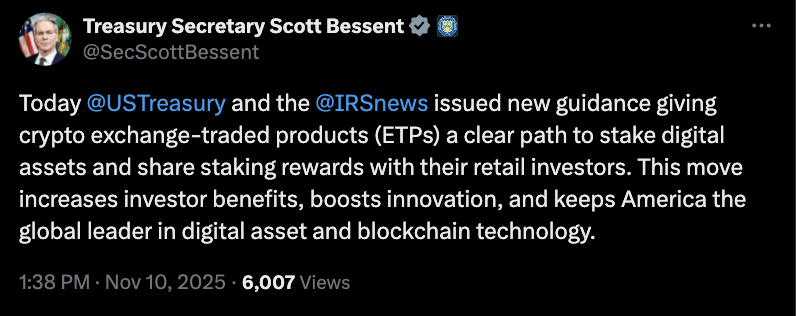The IRS crypto staking guidance provides a safe harbor for cryptocurrency exchange-traded products (ETPs), allowing trusts to stake digital assets under specific conditions. This update enables ETPs to participate in staking and distribute rewards to retail investors, promoting greater adoption while prioritizing investor safeguards and regulatory compliance.
-
IRS and Treasury Collaboration: The guidance stems from joint efforts by the IRS and U.S. Department of the Treasury to clarify tax implications for staking in regulated crypto products.
-
Eligibility Criteria: Crypto trusts must trade on national securities exchanges and hold only a single type of digital asset to qualify for the safe harbor.
-
Market Impact: Experts predict this will significantly boost staking participation, with institutional vehicles like ETFs now able to integrate staking yields without major legal hurdles.
IRS crypto staking guidance unlocks new opportunities for ETPs to stake assets and reward investors. Dive into the details on compliance, benefits, and future implications for crypto markets. Explore now for essential insights! (152 characters)
What is the IRS Crypto Staking Guidance?
IRS crypto staking guidance refers to the updated regulatory framework issued by the U.S. Internal Revenue Service in collaboration with the Department of the Treasury, aimed at clarifying tax treatment and operational rules for cryptocurrency staking within exchange-traded products. This guidance introduces a safe harbor provision that permits qualifying crypto trusts to engage in staking activities, share rewards with investors, and maintain compliance with federal tax laws. By addressing previous uncertainties, it facilitates broader participation in proof-of-stake networks for institutional investment vehicles.
The Internal Revenue Service, as the nation’s primary tax-collection agency, plays a pivotal role in defining how digital asset activities like staking are taxed. Staking involves locking up cryptocurrency to support blockchain operations in exchange for rewards, akin to earning interest in traditional finance. Prior to this update, ambiguity around tax liabilities and regulatory risks deterred many funds from incorporating staking, potentially limiting investor access to these yield-generating opportunities.
This development aligns with evolving cryptocurrency regulations, building on recent approvals for crypto ETPs. The guidance specifies conditions that must be met to qualify for the safe harbor, ensuring that staking does not expose investors to undue risks. For instance, trusts must mitigate cybersecurity threats, operational vulnerabilities, and conflicts of interest associated with staking protocols.

Source: Scott Bessent
Treasury Secretary Scott Bessent highlighted the guidance in a public statement, noting it offers crypto ETPs a clear path to stake digital assets and distribute staking rewards to retail investors. This endorsement underscores the administration’s commitment to fostering innovation in the digital asset space while upholding investor protections.
How Does the Safe Harbor for Crypto Trusts Work Under IRS Guidance?
The safe harbor outlined in the IRS crypto staking guidance applies to specific types of cryptocurrency trusts structured as exchange-traded products. To qualify, these trusts must be listed and traded on a national securities exchange, ensuring transparency and oversight. They are restricted to holding cash and units of a single type of digital asset, which simplifies tax reporting and reduces complexity in asset management.
Custodians play a critical role, as they must securely hold the digital assets and implement robust risk mitigation measures. The guidance emphasizes protections against key threats, including hacking, smart contract failures, and validator downtime in staking networks. For example, trusts are required to maintain adequate insurance coverage and conduct regular audits to verify compliance.
Supporting data from blockchain analytics firms indicates that staking rewards can yield annual returns of 4-10% for major proof-of-stake assets like Ethereum, depending on network participation rates. Bill Hughes, senior counsel at Consensys, an Ethereum software company, commented on the update, stating, “The impact on staking adoption should be significant.” He further explained, “This safe harbor provides long-awaited regulatory and tax clarity for institutional vehicles such as crypto ETFs and trusts, enabling them to participate in staking while remaining compliant. It effectively removes a major legal barrier that had discouraged fund sponsors, custodians, and asset managers from integrating staking yield into regulated investment products.”
This clarity is particularly timely, as it follows the U.S. Securities and Exchange Commission’s approval of generic listing standards for crypto ETPs in September. The IRS and Treasury explicitly reference this SEC rule change in their guidance, signaling coordinated regulatory progress. By harmonizing tax rules with securities standards, the framework encourages more ETPs to offer staking options, potentially increasing liquidity and retail access to the $100 billion-plus digital asset market.
From a tax perspective, the guidance treats staking rewards as taxable income at the time of receipt for the trust, with pass-through implications for investors based on their ownership shares. This aligns with existing IRS positions on cryptocurrency taxation, treating digital assets as property subject to capital gains and ordinary income rules. Investors should consult tax professionals to understand reporting requirements, such as Form 1099 updates that may incorporate staking income.
Broader implications include enhanced market efficiency, as staking contributes to network security and decentralization. For Ethereum post its 2022 merge to proof-of-stake, staking has locked up over 30 million ETH, representing more than 25% of the total supply. Similar dynamics could emerge for other assets as ETPs scale staking activities under the new rules.
Frequently Asked Questions
What Are the Key Requirements for Crypto Trusts to Stake Under IRS Guidance?
Under the IRS crypto staking guidance, trusts must trade on a national securities exchange, hold only cash and one type of digital asset, and use a qualified custodian. They also need to address investor risks like cybersecurity and operational issues through safeguards such as insurance and audits, ensuring safe participation in staking protocols. (48 words)
Will This IRS Guidance Affect Retail Investors in Crypto ETPs?
Yes, the guidance directly benefits retail investors by allowing ETPs to offer staking rewards, providing a compliant way to earn yields on holdings like Ethereum without direct blockchain management. It promotes accessibility through regulated products, potentially lowering entry barriers while maintaining tax transparency for income reporting. (45 words)
Key Takeaways
- Regulatory Clarity Boost: The IRS guidance eliminates key barriers, enabling crypto ETPs to integrate staking and distribute rewards to investors safely.
- Investor Protections Emphasized: Requirements for custodians and risk mitigation ensure that staking activities prioritize security and compliance in institutional products.
- Market Growth Opportunity: This update could accelerate adoption of proof-of-stake assets, advising investors to monitor ETP launches for enhanced yield options.
Guidance Coming on the Eve of the End of the Government Shutdown?
The timing of the IRS crypto staking guidance release coincides with efforts to resolve the ongoing U.S. government shutdown, which began on October 1 and lasted over 40 days. Reports indicate that several Democratic lawmakers in the Senate have expressed willingness to support a Republican-backed continuing resolution, extending funding through January and averting further disruptions.
At the time of this guidance’s issuance, the Senate had not yet voted on the measure. The shutdown has furloughed staff at critical agencies, including the SEC and IRS, potentially delaying routine operations. However, the proactive release of this update demonstrates the Treasury Department’s priority on cryptocurrency regulation amid fiscal challenges.
Historically, government shutdowns have raised concerns about regulatory continuity in emerging sectors like digital assets. For instance, during past interruptions, SEC reviews for crypto products have faced delays. The IRS’s decision to advance this guidance underscores the growing importance of clear tax policies for blockchain-based activities, even under constrained resources.
Stakeholders in the crypto industry, including asset managers and exchanges, have advocated for such clarity to build investor confidence. With the shutdown’s potential resolution, agencies like the IRS may ramp up further initiatives, such as expanded guidance on decentralized finance taxation or non-fungible token reporting.
Conclusion
The IRS crypto staking guidance marks a pivotal advancement in U.S. cryptocurrency regulation, offering a safe harbor for ETPs to engage in staking and deliver value to investors through rewards. By integrating secondary considerations like custodian safeguards and risk management, it balances innovation with protection in the evolving digital asset landscape. As institutional adoption grows, this framework positions the market for sustained expansion—investors are encouraged to stay informed on upcoming ETP offerings to capitalize on these compliant opportunities.
